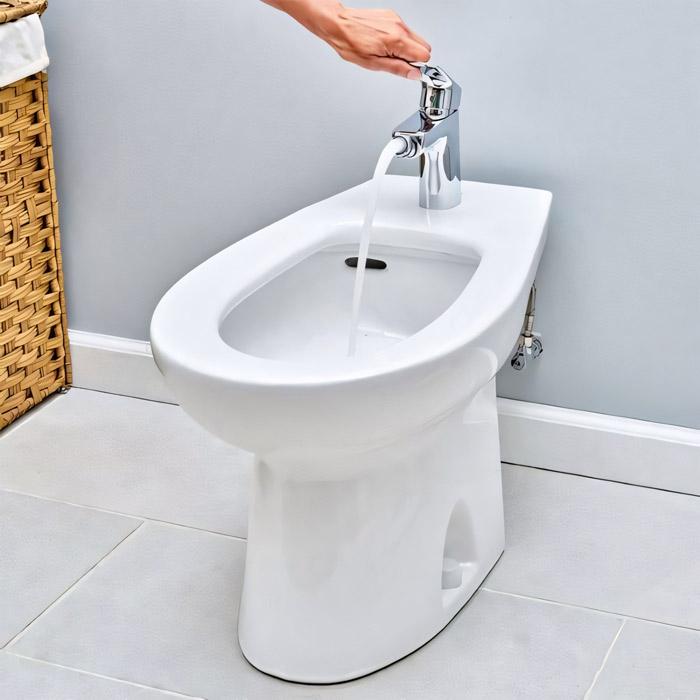
Bidets are becoming a frequent topic in household discussions across America. These fixtures offer a different way to maintain personal hygiene. They provide a gentle water wash after using the toilet, making users feel cleaner and more refreshed. This guide explores how bidets work, their advantages, various types, and more.
What Bidets Are and How They Work
A bidet operates as a water-dispensing device, primarily for cleaning oneself after using the toilet. Historically, this meant a separate basin people would sit on, filling it with water for washing. Modern bidets, however, mostly attach to or integrate with existing toilets. They deliver a controlled stream of water to help users clean their private areas.
The basic operation involves a nozzle, which extends from the bidet fixture. This nozzle sprays water at adjustable pressure and temperature. Users position themselves on the toilet seat, activating the bidet's spray with a button or lever. The water cleanses, then retracts. Some models include air dryers, removing the need for toilet paper entirely. The core purpose centers on using water for personal cleanliness.
Bidets are a Global Cleaning Custom
Bidets have been a familiar fixture in many countries for centuries. European nations, like France, Italy, and Portugal, commonly feature bidets in most homes. People there grew up using them as part of their daily routine. Parts of Asia, particularly Japan and South Korea, have embraced advanced bidet toilet seats with many automated features. South American countries also widely use these cleaning devices.
Their adoption in America has been slower compared to these regions. For a long time, bidets were considered a luxury item or an unfamiliar gadget. However, this trend has shifted notably in recent years. More American homes and businesses are installing bidets. Increased awareness about hygiene, environmental impact, and personal comfort is contributing to this rising popularity. People are seeking alternatives to traditional toilet paper for various reasons, making bidets an appealing option.
Benefits of a Bidet Beyond the Basics
Adopting a bidet offers several clear benefits in terms of health, environmental well-being, and personal comfort. Many individuals discover that these benefits lead to a better overall bathroom experience.
The primary gain from using a bidet involves superior personal cleanliness. Water cleans skin more effectively than dry paper alone. For women, this can mean a reduced risk of urinary tract infections (UTIs) and irritation, especially during menstruation or pregnancy. People dealing with hemorrhoids or other anal discomfort find the gentle water spray less abrasive and more soothing than wiping. It helps prevent irritation that wiping often causes. Those with mobility issues also get assistance from a bidet, making personal cleaning easier and more dignified.
Switching to a bidet significantly reduces the need for toilet paper. This has a positive ripple effect on the planet. Producing toilet paper requires cutting down trees, using large amounts of water, and consuming energy for manufacturing and transport. Less toilet paper use means fewer trees cut, less water consumption, and a smaller carbon footprint. While bidets use water themselves, the amount consumed during a typical washing cycle is minimal compared to the resources saved from not producing toilet paper. This change represents a small but meaningful step toward environmental care.
The financial benefit of owning a bidet becomes clear over months and years. While there's an upfront expense for the bidet unit and installation, the recurring cost of toilet paper drops dramatically. Families spend less money on buying toilet paper regularly. This saving can add up, making the bidet a sensible economic choice in the long run. The initial investment pays for itself through reduced household expenses.
Many individuals find the cleansing action of a bidet much gentler on their skin. Dry wiping can cause friction and irritation, particularly for sensitive skin or certain medical conditions. A bidet's soft water spray offers a soothing clean without any harsh rubbing. This mild approach provides a more comfortable experience, which many users come to appreciate deeply. It brings a new level of daily comfort and care.
Types of Bidets
The market offers different kinds of bidets, each fitting distinct needs and bathroom layouts. From simple additions to completely separate fixtures, choices abound. Knowing the differences helps people select the best model for their home or business.
Standalone Bidets
A standalone bidet is a separate plumbing fixture, resembling a low basin or toilet without a tank. It requires its own water supply and drain. Standalone bidets offer a dedicated cleaning station, separate from the toilet. They provide a very complete wash, often with a faucet for directing water. Some consider their look more refined or traditional. However, standalone bidets can be expensive. They also need considerable bathroom room, and their installation requires significant plumbing work, which adds to the cost. And moving to the bidet when you're done using the toilet can be inconvenient for some users. But if you want the very best in hygiene and cleaning, you can't beat a standalone bidet.
Bidet Seats
Bidet seats are popular because they replace a standard toilet seat directly. Installation is generally straightforward, requiring removal of the old toilet seat and mounting the new bidet seat. Many models include luxury features such as heated seats, warm water, and air dryers. They blend well with existing toilets, saving floor room. However, some models appear bulky, changing the toilet's look. And getting the right size and shape for your toilet bowl remains important for a good fit.
Bidet Attachments
These are simple additions that fit under an existing toilet seat. They use a small nozzle to spray water. Bidet attachments are typically the most budget-friendly option. Their simple design makes them easy to put in, often without needing complex tools or plumbing work. They provide basic cleansing without a large commitment. However, bidet attachments offer fewer features compared to bidet seats. The water usually remains cold unless connected to a hot water line, which adds complexity. And their appearance can look less integrated than a bidet seat.
Some Features to Consider for Your Bidet
Many optional features improve the bidet experience. Heated seats provide warmth during colder months. Air dryers gently dry the skin, reducing or removing the need for toilet paper. Deodorizers work to neutralize odors automatically. Self-cleaning nozzles rinse themselves before and after use, keeping them hygienic. Remote controls offer hands-free operation and custom settings for multiple users. Nightlights softly illuminate the bowl, making late-night trips easier without harsh overhead lighting. These additions add comfort and convenience.
Electric Versus Non-Electric Bidets
Bidets get power in different ways, leading to distinct user benefits and installation needs. The choice between electric and non-electric models influences comfort, features, and cost.
Electric Bidets
Electric bidets connect to an electrical outlet. They come with advanced features that rely on power. These models often provide warm water on demand, heated seats for comfort, and adjustable water pressure and temperature. Many include air dryers, deodorizers, and self-cleaning nozzles. Remote controls allow for easy function adjustment. However, electric bidets need a nearby electrical outlet, which might require an electrician to install. They generally cost more than non-electric options, both to buy and to operate due to electricity usage. And installation can be a bit more complex.
Non-Electric Bidets
Non-electric bidets work solely with water pressure from the existing water line. They don't need an electrical connection. Non-electric bidets are typically simpler and less costly. They require no electricity, saving on utility bills and simplifying installation. They represent a straightforward and dependable option for basic cleansing. However, non-electric bidets only use cold water, which might be a surprise for new users. They lack the advanced features found in electric models, such as heated seats, air dryers, or deodorizers. And water pressure adjustment is often more manual.
Can Bidets Replace Toilet Paper?
A frequent question concerns whether bidets can entirely replace toilet paper. For many users, the answer is yes. The water spray cleans thoroughly, often leaving a feeling of true cleanliness that paper alone does not provide. With the addition of an air dryer feature on electric models, toilet paper becomes unnecessary for drying.
Some individuals still prefer a small amount of toilet paper for a final pat dry or to check for completeness. This preference varies by person. However, the amount of paper used dramatically decreases, often by 75% or even more. The main goal of cleanliness is met effectively by the water. Reducing toilet paper use considerably lessens environmental impact and saves money, even if not fully eliminated.
Keeping Your Bidet Clean and Ready
Proper maintenance helps bidets work well and last longer. Regular cleaning is simple. Wipe down the bidet exterior, including the seat and nozzle area, with a mild cleaner and a soft cloth often. For models with self-cleaning nozzles, activate that feature regularly. For others, gently pull out the nozzle and clean it with a soft brush and water. Periodically, check for mineral buildup, especially in areas with hard water. Descaling solutions can remove calcification, keeping water jets clear and strong. Following the manufacturer's cleaning instructions helps maintain hygiene and function.
Bidets offer a superior cleaning method for intimate areas, providing health, environmental, and cost benefits. From basic attachments to feature-rich electric seats and separate fixtures, options suit various preferences and budgets. Understanding the different types and their capabilities helps in choosing the right one. With proper care, a bidet becomes a hygienic, resource-saving addition for any bathroom, changing daily routines for the better.


